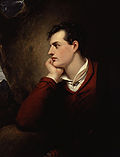
The Dream is a poem written by Lord Byron in 1816. It has been described as expressing "central Romantic beliefs about dreams". [1] It also describes the view from the Misk Hills, close to Byron's ancestral home in Newstead, Nottinghamshire. [2] Mary Chaworth of Annesley Hall, a distant relation for whom Byron had a boyhood passion, is the "Maid" of the poem. [3]
